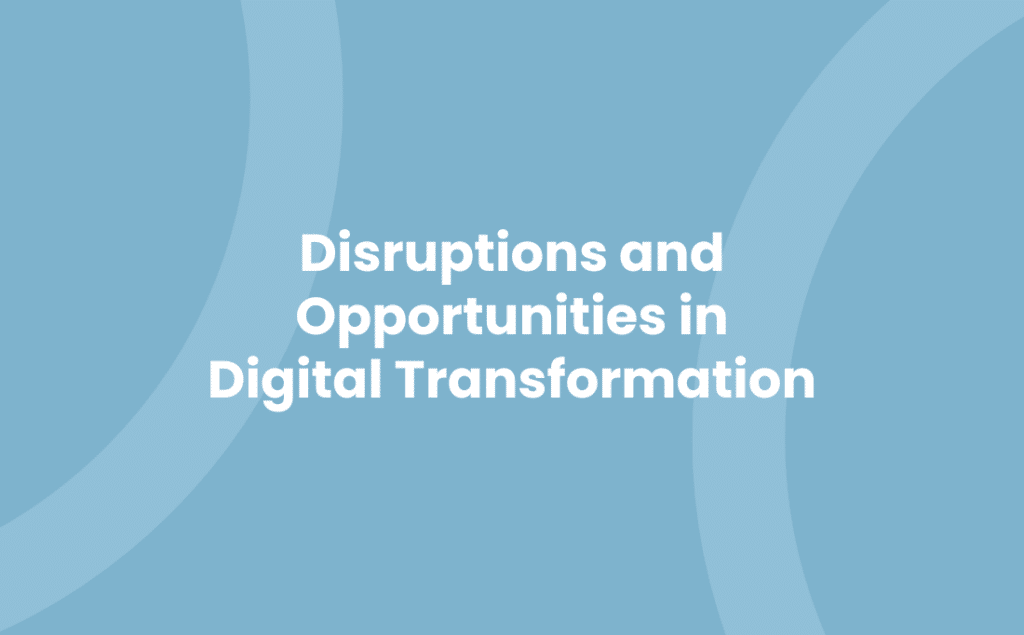Imagine a world where technology isn’t just part of your life, it’s reshaping your entire business landscape. Welcome to the era of digital transformation. A whirlwind of change, it’s causing disruptions across industries, forcing businesses to adapt or risk being left behind.
Whether you’re a seasoned tech guru or a novice, understanding these disruptions is critical. They’re not just changing the way we do business, they’re redefining success. So buckle up, as we delve into the heart of digital transformation and the industry disruptions you can’t afford to ignore.
From AI to Blockchain, we’ll explore how these technologies are causing ripples in the business world. You’ll get a glimpse of the future, and perhaps, a roadmap to navigate the digital revolution. Because in this era of digital transformation, it’s adapt or perish.
Understanding Digital Transformation
Digital transformation connects diverse sectors, reshaping the business world. You see, digital transformation disruptions aren’t anomalies. They signify the evolution of industries through technology. Artificial Intelligence (AI) and blockchain, for instance, not only serve as powerful tools but also benchmarks for industry innovation.
When dissecting digital transformation, you encounter terms like processes, customer experience, and business model. For example, processes refer to the use of technology to improve efficiency, such as automated software for data management. In contrast, customer experience illuminates the impact of e-commerce platforms in providing a seamless shopping experience. Finally, business models focus on the changes companies undertake, like shifting to software-as-a-service (SaaS) models.
With each technology innovation, the implication extends beyond a single industry. Take AI, it’s not reserved for tech companies anymore. Retail businesses implement AI-chatbots to improve customer service, while healthcare utilises AI algorithms to predict patient conditions.
Blockchain, traditionally associated with cryptocurrencies, has ripples extending to finance and supply chain management, thanks to its transparency and security features.
These disruptions are significant. They represent the next stage of business evolution, a stage where businesses don’t merely exist in the digital realm, but also thrive in it. The key is understanding these digital transformation disruptions and adapting them into your business strategies. This readiness offers an edge, granting a smooth ride in the wake of digital industry disruptions instead of being left in the digital dust.
Digital Transformation and Industry Disruptions
Digital industry disruptions stand at the forefront of 21st-century business innovation. As firms continue hinging their survival strategies on technology, it’s pertinent to grasp these disruptions.
Firstly, let’s delve into the profound way AI cuts across industries. Originally the digital transformation domain of tech giants, small and medium enterprises (SMEs) have taken to AI like bees to honey. Retail firms, for instance, leverage AI to predict consumer behaviour and personalise their offerings. Similarly, healthcare establishments deploy AI systems for accurate diagnosis and targeted treatments, greatly improving patient outcomes.
Next, we focus on Blockchain’s increasing influence. Renowned as the technology powering cryptocurrencies, its application has grown to include supply chain tracking, digital identification, and secure transactions. For SMEs, integrating such technology fosters trust, transparency, and efficiency, crucial attributes to thrive in today’s volatile markets.
Evolving customer preferences pose another digital transformation disruption. The rise in digital ecosystems equipped with advanced analytics tools allows businesses to dig deeper, gaining insights into their customers’ behaviour. Understandably, such treasure troves of data drive businesses towards revamping their models to align with their client’s needs, fostering more robust user engagements.
In essence, digital transformation disruptions bring about an unprecedented change in industries. Reinforcement is found in automation, a phenomenon revolutionising operational processes. From manufacturing to services sectors, automation paves the way for precision, timeliness, and cost-efficiency. Businesses that can use such technology strategically gain an edge over their competitors, mastering their fields with incredible prowess.
Lastly, digital transformation brings about a shift in business models. E-commerce platforms highlight this change, where traditional brick-and-mortar businesses transition to online trading. Companies like Amazon and Alibaba set the pace, exhibiting extraordinary success with virtual stores. This disruption encourages businesses to augment their physical operations with digital alternatives, a step instilling resilience and adaptability.
Businesses that lean into digital transformation disruptions, absorbing new technologies, exploring digital ecosystems, and adapting to evolving models, position themselves to ride the wave. This dynamic approach keeps enterprises not just afloat but also robust, thriving in the digital age.
The Benefits of Digital Transformation in Business
When your business embarks on the journey of digital transformation, you open doors to multiple benefits, setting yourself apart in an industry disrupted by the digital era.
Firstly, digital transformation cultivates responsive agility in companies, making them equipped to handle rapid changes in the landscape. Implementing digital solutions means organisations can quickly adapt strategies, making adjustments based on real-time data and analytics. For example, an online retailer’s ability to update inventory in real-time during peak sales events is a testament to this.
Secondly, businesses experience improved efficiency and productivity. Cutting-edge solutions coupled with improved processes lead to less waste, streamlined workflows, and ultimately, cost-effectiveness. For instance, take the case of automating mundane tasks where software can complete tasks in a fraction of the time a human would, without errors.
Thirdly, there’s customer satisfaction and overall experience. Digital transformation means customer’s profound interactions with your business could happen on digital platforms. A brilliant user interface, easy navigation, and personalised communication‚ all these add to customer delight. Look at Amazon’s recommendation system‚ it’s made entirely for user satisfaction, serving personalised product suggestions based on their purchase history.
Fourthly, providing innovative products or services becomes a reality with digital transformation. The synergy between creative thinking and technological advances makes it possible for businesses to meet evolving customer demands with innovative solutions. For example, Uber revolutionised the taxi industry by connecting users with drivers via a digital app.
Finally, businesses embracing transformation harness the power of data. Big data and analytics play a role in almost every decision, from marketing to supply chain optimisations. Take the case of Twitter utilising analytics to understand trending topics, and advertisers leveraging that metadata‚ the power of data is undeniable.
Braving the waters of digital transformation disruptions provides businesses with a plethora of advantages. Invigorating agility, increasing efficiency, enhancing customer experience, fostering innovation, and utilising the power of data‚ every digital step forward unlocks another layer of potential in your business amid digital industry disruptions.
Digital Transformation Challenges
While the digital transformation journey promises unprecedented opportunities, it’s not without its hurdles. Here, we offer an insight into the obstacles businesses often encounter during digital transition.
Cybersecurity Threats
In an era defined by data, protecting sensitive information stands paramount. Cybersecurity threats pose a significant challenge to digital transformation. Even as you integrate innovative tech into your operations, increasing digital touchpoints can leave your business susceptible to cyber threats.
Skills Gap
Navigating the digital landscape requires vital expertise. A lack of necessary skills stands as a major barrier in the digital transformation journey. Upskilling employees, from tech understanding to data literacy, is key to bridging the gap.
Resistance to Change
Digital transitions involve radical changes that may arouse resistance. Some staff might fear job loss to automation, hindering your transformation process. To overcome this, encourage a culture that embraces change and prioritises lifelong learning.
Complex Implementation
Commencing a digital transformation process is an intricate task. It demands strategic planning, from selecting suitable technology to projecting implementation costs. Overlooking any detail may lead to ineffective digitalisation and financial losses.
Data Management
Managing numerous data points generated by digital processes is a complex issue. Companies can struggle with storing, interpreting, and leveraging this data successfully.
By tackling these challenges and propelling digital transformation, businesses can turn disruptions into possibilities for increased efficiency and profitability. It’s important to remember, digital transformation isn’t a one-off event, but an ongoing process involving consistent commitment and perseverance.
Case Studies: Successes in Digital Transformation
Upon reflection on the ground-breaking benefits and deterring challenges of digital transformation disruptions, studying real-world examples can demonstrate how best to proceed.
Case Study #1: Domino’s Pizza
Across business landscapes, Domino’s Pizza takes centre stage as a successful protagonist of digital transformation in play. About a decade ago, poor performance rattled their business model, with minimal customer engagement and slow growth rate, triggering significant concerns. However, through utilising digital tools, Domino’s swiftly turned around, dominating the market today.
Their winning strategy involved a mix of data analytics, automated delivery bots and e-commerce platforms to enhance customer service and experience. By analysing customer data, they honed in on customer preferences, leading to better customer engagement and increased sales. Automated delivery bots served as a testament to their use of AI, easing logistics while creating a buzz in the market.
Case Study #2: GE
General Electric (GE) offers another inspiring example of successful digital transformation. Initially, the company struggled with obsolete mechanisms and decreased productivity across various domains. However, through a committed digital transformation strategy, they managed to revolutionise the way they function and deliver services, firmly placing themselves back on the growth trajectory.
GE leveraged digital industry disruptions to pioneer their ‘Industrial Internet.’ The concept relies upon streamlining manufacturing processes through integrating Internet of Things (IoT) and other cutting-edge digital technologies. The result was phenomenal – upping productivity, quality, compliance and profitability.
Every case study above showcases that digital transformation isn’t a quick fix, but a journey requiring long-term commitment and perseverance, even when faced with imposing challenges. It emphasises the importance of embracing change when treading on the path of digital transformation, learning from disruptions and leveraging them to unlock enhanced efficiency and profitability. With the right approach, one can transform these potential digital transformation nightmares into stories of success.
The Future of Digital Transformation
Based on prevalent trends, technologies, and disruptions in the digital industry, one can forecast the path digital transformation is likely to take. Three key domains underpin this future trend: increased integration of Internet of Things (IoT) devices in businesses, proliferation of artificial intelligence (AI) and machine learning (ML), and a more pronounced shift to cloud computing.
Increased business adoption of IoT devices signifies a major facet of digital transformation disruptions. Devices such as smart monitors, sensors, and automation systems present opportunities for businesses to make data-driven decisions, optimise operations, and streamline service delivery, thereby boosting efficiency. For instance, in manufacturing, companies might employ IoT technology in their assembly lines to track real-time data regarding product quality, machine performance, and maintenance needs.
Artificial intelligence and machine learning further escalate the digital industry disruptions, driving enterprises towards more predictive and prescriptive analytical capabilities. Businesses could harness the proficiency of AI and ML algorithms to unearth hidden patterns in their vast data reservoirs, enabling them to forecast trends, anticipate customer behaviour, and adapt strategies accordingly. As an example in retail, businesses might use AI and ML for predictive inventory management, ensuring stock availability while reducing excessive inventory costs.
Lastly, cloud computing signifies a notable future trend in digital transformation. Embracing cloud technologies allows businesses to access and analyse data remotely, collaborate easily, and scale up operations on demand. In healthcare, organisations might leverage cloud computing for virtual care delivery, patient data management, or collaboration across various medical teams.
While these potential disruptions present immense opportunities, they also require businesses to stay agile, adapt to changes quickly, and be tenacious in navigating through emerging challenges. The key to mastering future digital transformations, therefore, lies not just in embracing new technologies, but also in developing resilience towards the inevitable disruptions they entail.
Conclusion
Embracing digital transformation is no longer an option – it’s a necessity. As seen with Domino’s Pizza and General Electric, the strategic use of technologies like AI, Blockchain, and IoT can significantly enhance business efficiency and profitability. The future promises even more disruption with the integration of IoT devices, the rise of AI and ML, and widespread adoption of cloud computing. These trends provide incredible opportunities for your business to make data-driven decisions, predict trends, and scale operations. But remember, to capitalise on these opportunities, your business must remain agile, adaptable, and resilient. So, gear up for the digital revolution and let it be the catalyst that propels your business into a future of unprecedented growth and success.



